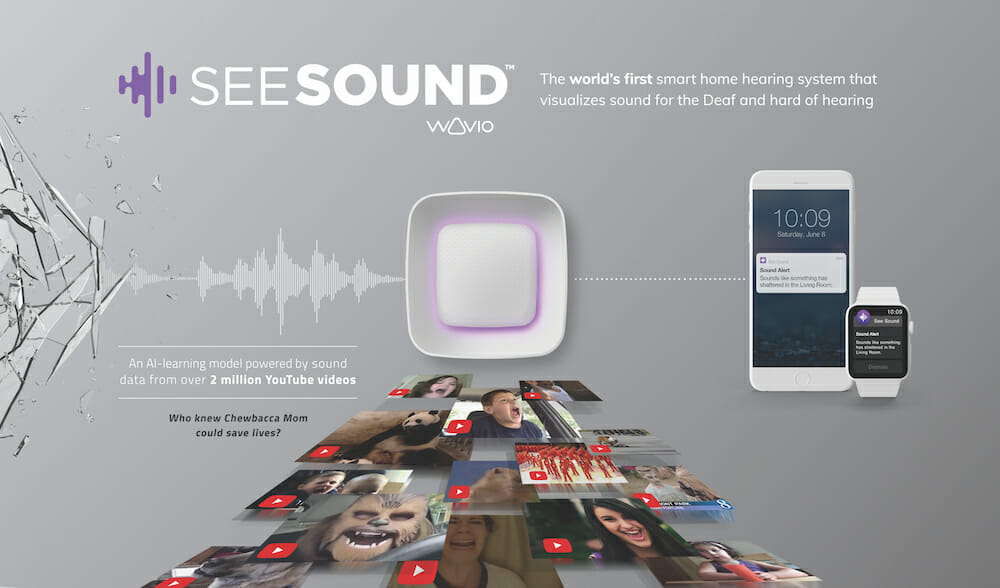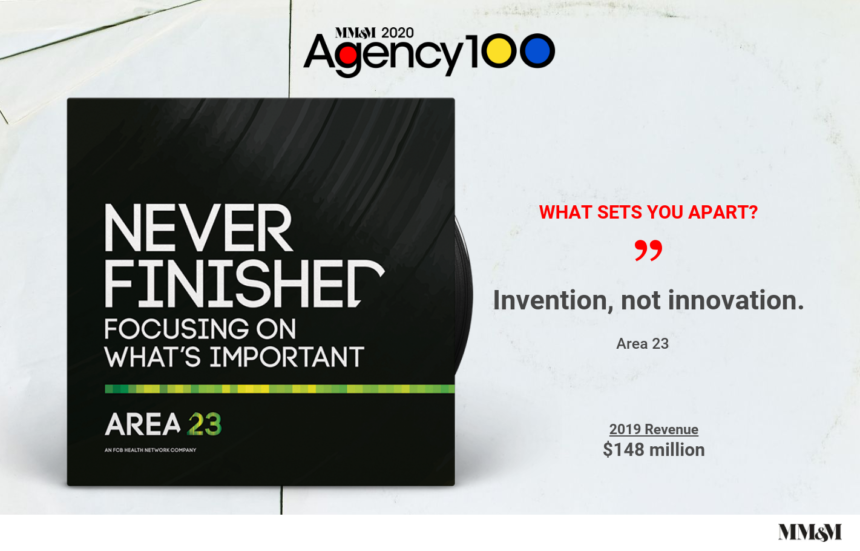In 2019, Area 23 enjoyed a third straight year of substantial growth and won many of the industry’s most coveted awards — including gold in MM&M’s Large Healthcare Agency category. But to hear its principals tell it, many of the successes weren’t by design.
“Quite frankly, some of it was unplanned and unintentional. We didn’t pitch,” says Area 23 president Renée Mellas.
After 35% growth over the course of 2017 and 2018, the agency contended with the distinctly first-world problem of having to turn down new business during 2019. “When an existing client calls you with an opportunity and says, ‘We love working with you guys and we want to expand our relationship, and you don’t have to pitch,’ it’s kinda hard to say no.” She adds the agency declined somewhere in the neighborhood of 40 RFPs.
Mellas proudly details 10 assignments Area 23 added to its portfolio last year sans pitch. Some arrived through expanded relationships with existing clients such as Eli Lilly (for oncology brands Verzenio and Loxo) and Horizon Therapeutics (thyroid eye disease treatment Tepezza); some came by virtue of being in the right place at the right time (it scooped up assignments from Urovant Sciences and Nektar after both companies decided to switch agencies; it added business from Genentech from a FCB Health network sibling); and others stemmed from its reputation as the “It” agency with a bent for cutting-edge creative (Invitae, Allergan and Myovant Sciences all came on board after informal sit-downs with Area 23 team members). All of the agency’s engagements are on an AOR basis.
Though Mellas says the agency “isn’t allowed” to talk specifically about its financials, she finds it hard to resist in the wake of the good fortune. “Put it this way: Just take our logo and add a percent sign,” she quips. Based off the $120 million in 2018 revenue Area 23 reported to MM&M last year, that would place the agency just south of $150 million in 2019. Some 40% of the growth came from new clients.
Chief creative officer Tim Hawkey notes that having the discipline to say thanks-but-no-thanks has allowed Area 23 to align with organizations that are similarly minded. “We end up with relationships that are much more fruitful,” he says.

And while he and Mellas are keenly aware that over-enthusing about the agency’s recent successes could put a target on their back, they remain exceedingly careful about how they brand the company. “We don’t necessarily want to be the biggest agency out there. It’s not, ‘How much revenue and how many people?’” Mellas stresses. “We want to do the best work, and sometimes that means being more selective.”
Since its debut in 2008, Area 23 has focused on invention — which, Hawkey believes, makes for a more practical methodology than “innovation.” He says the latter has, in essence, been buzzworded out of meaning.
“We feel like we’re leading the way among agencies in transitioning to a product-based approach and not just an ideas-based approach,” he explains.
By way of example, he points to work on See Sound, an AI-powered product for the deaf that Area 23 created in collaboration with the startup Wavio. The device, which combines data, machine learning and mobile technology to help deaf people identify sounds in their home, won the Cannes Innovation Lions Grand Prix last summer.
We feel like we’re leading the way among agencies in transitioning to a product-based approach and not just an ideas-based approach.
Tim Hawkey
But that was just the beginning of the relationship. In April, Area 23’s parent company, FCB Health, announced it had taken a minority stake in Wavio. So now Area 23 finds itself working alongside its new corporate half-sibling to manufacture and commercialize See Sound — and, as part of the deal, will receive a percentage of product sales. The goal is to push 5,000 units to market this year (most are already claimed via preorders) and attract a Series A round of investment before the nationwide commercial launch.
In the two years it took to bring See Sound to life, Area 23 learned a lot about how it wanted to grow, Hawkey says. The process of creating the device revealed in-house capabilities that were being underutilized, such as AI expertise and the ability to 3-D print prototypes.
“We’ve been able to translate that into offerings for our clients,” Hawkey says. “Instead of telling them to use their imagination, we now just show them what we’re talking about.”
Along those lines, in March Area 23 engineered Down and Out Kidney, a campaign for Horizon’s Krystexxa targeting nephrologists. Its immersive video element features a kidney character whose interactions with uric acid “endanger not only himself, but his friends — foot, hand, bone and heart,” as the press release puts it. Hawkey says that Area 23 helped the client envision the creative by 3-D printing a model of the character.
A more formal initiative is the agency’s If/Then Institute, an integrated strategy framework that takes advances in digital trends and marketing transformation and synthesizes them to help solve real-world marketing challenges. It operates “like a transtheoretical mapping engine,” as the agency describes it. “We input insights from research, and the framework outputs the proper transformative psychological model.”

With Area 23’s growth came a host of new faces, as the firm’s head count jumped from 440 at the end of 2018 to 600 at the end of 2019. Additions included SVP, group creative directors Renata Maia and David Traini, who oversee creative for much of the firm’s work on behalf of Boehringer Ingelheim/Eli Lilly, Urovant Sciences, Myovant Sciences and Allergan. The agency also added SVP, group management director Kathleen Gillooly, who manages four brands in the BI/Lilly portfolio.
Mellas points to EVP, executive director, integrated strategy Julie Pilon as an especially significant hire. Previously chief strategy officer at Publicis Health + Sapient, Pilon has a coveted background in data and analytics. “Engagement/digital, medical and brand all report up to her,” Mellas notes. “That integration is part of what makes the agency unique.”
To accommodate the extra bodies, Area 23 is building out a new floor in its midtown Manhattan headquarters. Alas, the planned May move-in date was disrupted by the COVID-19 pandemic.
“We’re worry-warts,” Hawkey says. “But we’re proud to share that the transition to working from home has been relatively smooth for us.”
The best marketing we saw in 2019…
Project Understood, from FCB Canada on behalf of the Canadian Down Syndrome Society. It’s the perfect culmination of the trend to make technology accessible for all. It exposes a problem few knew about and it creates a viable path to solve that problem, all while telling a heartwarming story. — Renée Mellas
From the June 01, 2020 Issue of MM+M - Medical Marketing and Media








